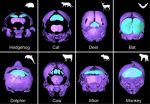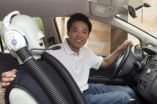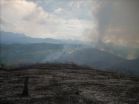(Press-News.org) VIDEO:
Researchers at the La Jolla Institute for Allergy & Immunology have identified the specific type of immune cells that orchestrate the inflammatory attack on the artery wall, which is a...
Click here for more information.
SAN DIEGO – (August 14, 2012) – Most people probably know that heart disease remains the nation's No. 1 killer. But what many may be surprised to learn is that cholesterol has a major accomplice in causing dangerous arterial plaque buildup that can trigger a heart attack. The culprit? Inflammatory cells produced by the immune system.
A number of research studies have demonstrated inflammation's role in fueling plaque buildup, also known as atherosclerosis, which is the underlying cause of most heart attacks and strokes, but knowledge of which immune cells are key to this process has been limited – until now.
Researchers at the La Jolla Institute for Allergy & Immunology have identified the specific type of immune cells (CD4 T cells) that orchestrate the inflammatory attack on the artery wall. Further, the researchers discovered that these immune cells behave as if they have previously seen the antigen that causes them to launch the attack. "The thing that excites me most about this finding is that these immune cells appear to have 'memory' of the molecule brought forth by the antigen-presenting cells," said Klaus Ley, M.D., a renowned expert in vascular immunology, who led the study in mouse models. "Immune memory is the underlying basis of successful vaccines. This means that conceptually it becomes possible to consider the development of a vaccine for heart disease."
Dr. Ley said he believes the antigen involved is actually a normal protein that the body mistakes as being foreign and therefore launches an immune attack resulting in inflammation in the arteries. "Essentially, we're saying that there appears to be a strong autoimmune component in heart disease," he said, explaining that autoimmune diseases result from the body's mistaken attack on normal cells. "Consequently, we could explore creating a "tolerogenic" vaccine, such as those now being explored in diabetes, which could induce tolerance by the body of this self-protein to stop the inflammatory attack."
The study was published online Monday in the Journal of Clinical Investigation in a paper entitled "Dynamic T cell–APC interactions sustain chronic inflammation in atherosclerosis."
Dr. Ley cautions that creating a vaccine is a complex process that could take years to develop. However it offers exciting potential. "If successful, a tolerogenic vaccine could stop the inflammation component of heart disease," he said. "This could probably be used in conjunction with the statins (cholesterol-lowering drugs) that have already taken a significant chunk out of the numbers of people with heart disease. Together, they could deliver a nice one-two punch that could be important in further reducing heart disease."
Dr. Ley said antigen-presenting cells take up infectious organisms, foreign materials and self-proteins (in the case of autoimmune diseases) and "chop them into little pieces called epitopes" and then display the pieces on the surface of the cell. "The T cell comes along, and if it has the correct receptors, it will recognize the epitope pieces and make cytokines (a type of immune system soldier molecule) that attack the material and cause inflammation." Autoimmune diseases include such illnesses as type 1 diabetes, rheumatoid arthritis and multiple sclerosis.
In the study, Dr. Ley and his team used live cell imaging techniques to track immune cells in normal and artherosclerotic mouse aortas. He said in mice with atherosclerosis, there are a large number of antigen-experienced T cells that have already seen certain epitope pieces (from self proteins) that they perceive as foreign. "The T cells talk to the antigen-presenting cells and, in response, make cytokines that launch an attack. This is what makes the inflammation in the vessel wall persistent." Inflammatory cells join fat and cholesterol to form artery-clogging plaque that can eventually block blood flow, leading to a heart attack.
"It wasn't previously known that antigen-experienced T cells existed in the vessel wall," said Dr. Ley. "This experiment makes me now believe that it may be possible to build a vaccine for heart disease."
###
About La Jolla Institute
Founded in 1988, the La Jolla Institute for Allergy & Immunology is a biomedical research nonprofit focused on improving human health through increased understanding of the immune system. Its scientists carry out research seeking new knowledge leading to the prevention of disease through vaccines and the treatment and cure of infectious diseases, cancer, inflammatory and autoimmune diseases such as rheumatoid arthritis, type 1 (juvenile) diabetes, Crohn's disease and asthma. La Jolla Institute's research staff includes more than 150 Ph.D.s and M.D.s. To learn more about the Institute's work, visit www.liai.org.
END
Whilst the most powerful earthquake since records began hit Japan in 2011, triggering a massive tsunami which devastated much of the country, space scientists involved in one of the 'brightest' international Sun missions continued working tirelessly at the Institute of Space and Astronautical Science in Sagamihara, Japan, to capture new data from our turbulent star.
These latest Hinode results, to be discussed in a meeting at the University of St Andrews this week (Tuesday 14 August), include new data on the structure of the Sun's coronal magnetic field, obtained whilst ...
Guided press tour
The excavation will be open to the press on Wednesday 15 August from 13.00 to 15.30.The tour starts at Alkenvej 171, 8660 Skanderborg.
...
Sulphur dioxide emissions from shipping have sharply decreased in EU ports thanks to an EU policy which limits sulphur content in fuels for ships at berth or at anchor in ports. Scientists at the European Commission's Joint Research Centre measured key air quality parameters in Mediterranean harbours before and after the entry into force of the low-sulphur requirements in January 2010. In European harbours they found an average decrease of 66% in concentrations of sulphur dioxide, a chemical compound that poses risks to health and the environment. Measurements taken in ...
People who give positive encouragement and constructive criticism could be wasting their breath according to the latest research from a psychology expert at Queen Mary, University of London.
The study, published in the journal Frontiers in Neuroscience, found that when people received either positive or negative feedback about their performance on complex decision-making tasks, it made their decision making worse.
Study author Dr Magda Osman explained: "The kind of task people had to perform was difficult and demanding. So, when people received positive or negative ...
The mammalian skull, including that of people, is composed of about 20 bones. Fish, reptile and bird skulls, however, have considerably more. After all, when mammals evolved from reptile-like vertebrates 320 million years ago, the skull's structure became simplified during its development and the number of skull bones decreased.
Some bones were lost in the lineage leading to mammals in the course of evolution, especially a number of skull roof bones. The skull's interparietal, which is one of the skull roof bones, particularly puzzled researchers: on the one hand, it ...
They're sleek. They're fast. They're powerful. And, they are deafening. Furthermore, those Top Gun military jets need to be up in the air in the wee hours – over land – to simulate their landings on aircraft carriers. But innovations out of the University of Cincinnati's Gas Dynamics and Propulsion Laboratory are showing promise in reducing the intense noise of these supersonic jets without impacting their power. It's research that can help neighborhoods slumber a little more soundly, keep their windows rattling a little less loudly and also protect the hearing of military ...
University of Cincinnati research – from noise reduction in sophisticated military jets to quieter car rides – will be presented at INTER-NOISE 2012, the 41st International Congress and Exposition on Noise Control Engineering, to be held Aug. 19-22 in New York City. UC is among only a few universities with a specific focus on vehicle noise control.
The UC research to be presented at INTER-NOISE:
UC innovations to reduce the noise of the nation's most sophisticated military aircraft. Jeff Kastner, research assistant professor in the UC College of Engineering and Applied ...
All noise is not necessarily equal – especially when it comes to sound minimization in automobiles.
For instance, automakers have long used sound-absorbing materials (passive control) in the design of cars in order to minimize engine noise and the "routine" noise of tires traveling on smooth pavement at a consistent speed. However, a means to minimize sudden, unexpected noises – like those from an encounter with potholes, bumps or other roadway pavement obstacles – has been more problematic.
A significant step in countering such unexpected roadway noises is the development ...
Until recent decades the Atlantic Rainforest covered a large area of today's Brazil from Amazonas to present-day Argentina. In the 1970s, after years of deforestation, this rain forest was almost completely destroyed, mainly replaced by cattle pastures. This study reveals an unexpected aspect of deforestation. Thorsten Dittmar's team and colleagues from Brazil and the USA show that the common practice of slash and burn left huge amounts of charcoal in the soil. This charcoal is washed out by rainfalls and transported by rivers into the Atlantic Ocean. The soluble fraction ...
WASHINGTON – Girls with attention deficit hyperactivity disorder are significantly more likely to attempt suicide or injure themselves as young adults than girls who do not have ADHD, according to research published by the American Psychological Association.
Young women diagnosed with attention deficit hyperactivity disorder as girls, particularly the type with early signs of impulsivity, were three to four times more likely to attempt suicide and two to three times more likely to report injuring themselves than comparable young women in a control group, according to ...




